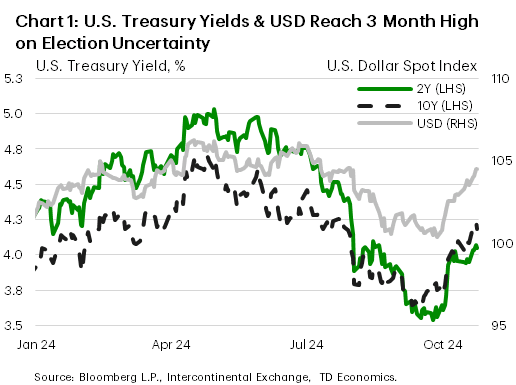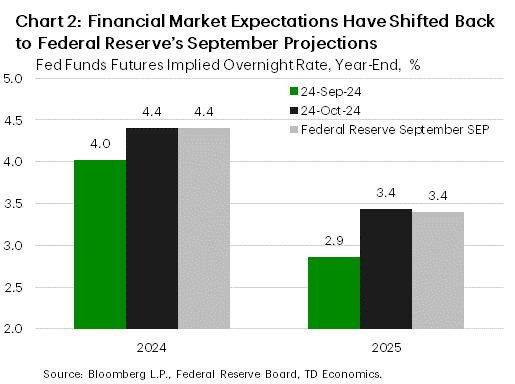Canadian Highlights
- The Bank of Canada made a super-sized interest rate cut this week, taking the overnight rate to 3.75%. The Bank cited the significant decline in inflation as a key factor, but their inflation forecast was little changed from July.
- The Bank’s data dependence has made policy decisions backward looking. If they had focused on their inflation forecast rather than the data, they would have cut rates earlier in the year.
- This focus on the here and now, rather than the forecast may result in overdoing it and needing to recalibrate rates later. Resulting in a more stop-and-go path for interest rates.
U.S. Highlights
- U.S. Treasury yields continued to rise as the race for the White House tightened, leading to elevated uncertainty regarding the future path of fiscal policy.
- Federal Reserve speakers this week noted that further reductions in interest rates would be warranted, although incoming data supported a cautious approach.
- Existing home sales fell to a fourteen year low in September. Elevated interest rates, combined with expectations for lower rates moving forward, worked to keep demand subdued.
Canada – Is 50 the new 25?
No, I’m not talking about age, although I’d greatly benefit from that view! I knew I would eat crow on Wednesday’s Bank of Canada (BoC) call with the high market pricing for a 50 basis point (bp) cut. There’s no regret in having conviction that risks need to be managed when the Bank delivers a rate cut that historically aligns to emergency periods. It could condition Canadians to expect data misses to be met with large monetary responses. I was hoping this would be clearly addressed in the press conference. Unfortunately, it was not, and there was little indication on where the bar is set for another 50 bps in December.
Within the press release, oil was mentioned twice, which is not common fare. It’s been a contributor to a larger-than-expected decline in inflation, but all it would take is a supply disruption from geopolitical events to cause a spike. If so, would we assume all bets are off on future rate cuts? Of course not.
Next up were shelter prices, which were noted to be decelerating. Of course! This is highly forecastable and observable. The peak impact of the rapid escalation in mortgage rates is in the rear-view mirror. And, the act of cutting interest rates takes heat off mortgage interest costs, where there’s a “circular reference” into inflation metrics. Almost a fifth of shelter costs derives from this single input and models have correctly predicted this easing in the growth-impulse.
Next up was mention that the Bank’s preferred core measures were just under 2.5%. The memo that communicated 2.5% was a meaningful threshold, rather than the midpoint of the inflation range, must have gotten lost. The Bank also did not make significant changes to their outlook on the economy or core inflation metrics, except to mark-to-market in Q3.
Carolyn Rogers offered the clearest (and most transparent) explanation — with the benefit of time and more data, the 50 bps cut reflects greater confidence that inflation will hold near 2%. By extension, a faster normalization in rates is warranted. However, this logic automatically argues for at least one more 50 bps cut in December, absent a large miss to the upside on the Bank’s forecast. No surprise, markets have about two-thirds of that priced in.
Normalization means getting back to the BoC’s range for the neutral rate, which they estimate is between 2.25% and 3.25%. The midpoint is cited as the ideal target. Now, that range is not static. It’s regularly revised based on population and productivity trends. For instance, the government’s recently announced changes to immigration targets should result in a downshift in the range due to labour market impacts. In addition, Canada’s persistent poor productivity performance offers further rationale to lower the range. However, doing so would only mean that the BoC policy rate is even further away from neutral than originally believed, yet another argument for several 50 basis point rate cuts to achieve normalization. But as it currently stands, this requires returning to 2.75%, at a minimum. There was no discussion at the press conference on the appropriate pace, other than if the BoC’s forecast is met, interest rates will be cut again.
Let’s get back to fundamentals and pull the lens back on what’s really motivating outsized rate cuts. For decades, central banks drilled into the public mindset that the best approach in monetary policy was:
- Gradual (and transparent) adjustments
- Decisions reflect a forward-looking economic and risk landscape, generally within the 12-to-18-month range.
But that was the pre-pandemic world when central bankers had reasonable confidence in forecast models and historical relationships. Since then, the communication pivoted to focusing analysts on the here-and-now data. Confidence requires irrefutable proof, rather than being about 60% of the way there on the data trend.
Understandable given that the pandemic created a persistent inflation surge that models were not designed to predict. The shock occurred simultaneously along the demand and supply channels. Most macroeconomic models have greater sophistication in understanding the demand side of the equation, rather than the supply side. But here too there were big failures. For instance, the unemployment rate typically had a great track record in predicting household financial stress and consumer patterns. But it had no chance on accuracy during the pandemic cycle that displayed historic departures as the pause button was hit on loan repayments and household bank accounts were backfilled with massive government transfers.
Those days are long gone, and the learnings and sophistication of models has since broadened, as has the understanding of those who rely on them. With the absence of unusual or unique factors, there should be greater confidence in the predictive outcomes of models and judgement. Yet, the central bank keeps its eyes and communication trained on the immediate data to influence decisions. Effectively, decisions are based on data fluctuations largely informing one-quarter ahead rather than the medium term. This is not just a Bank of Canada phenomenon, but a global central bank trend.
What could this mean in the bigger picture? One outcome is an amplification of interest rate volatility. No longer are 50, 75 or 100 basis point moves reserved for the “oh shoot!” emergency moments where there’s high risk of a recession. Interest rate cycles have a later start, but then get compressed, creating larger jumps and tumbles, or volatility.
Is that a bad thing? Not in every aspect. As the BoC noted, they want to stick the landing. A larger interest-rate move isn’t a signal that they know something you don’t. It is an admission that they are behind the curve because that’s the natural state that occurs when the emphasis is on changes in the near-term data. By the time you see the data, observe persistence, you’ll naturally be behind the curve. The data, after all, are already backward looking. But at least once this condition is known, the adjustment is swift to try to prevent more economic weight. As the BoC Governor noted, we took a bigger step because inflation is back to the 2% target, and want to keep it there.
However, this can likewise train households to develop a “pile in” psychology. Canadians are not shy about taking on debt. And the housing market is indeed a sport, with a team fielded by population growth and insufficient supply within key segments, like the detached market. The Canadian history on housing is clear: It responds quickly to interest rate movements. And we’ve just come out of a lengthy pent-up demand cycle. In addition, the government is adding fuel to the market with recent policy changes that will stoke demand amongst first time buyers. That means there will be two big channels feeding through the housing market simultaneously, even as immigration flows get tapped down with the government’s recent announcement.
There will be those wanting to “beat the crowd” and secure “a deal” before the combination of government measures and even lower interest rates create a groundswell in demand that risks flipping various markets from balance back to a sellers’ market. But some will be forced to wait longer, in need of those new government measures. So for those with eyes trained on the here-and-now data, the next couple of months may produce housing data that might look like Canadians are not overly responding to interest rate cuts, but my money is on nature and nurture coming back into play. 2025 could display a stronger response in housing demand as monetary and government policy collide into a one-two punch to unleash pent-up demand.
If the Bank of Canada is going to prioritize the near-term data towards outsized rate cuts, we must consider that it would need to be equally responsive to risk-development. This can create an overcorrection on interest rates, going down too deep only to be fine tuned again on the upside as the household spending impulses kick in more suddenly relative to when interest rates follow more gradual cycles. Likewise, it can result in more stop-and-go monetary policy.
U.S. – Countdown to Election Day
One of the most anticipated global events of 2024 is now nearly a week away. As financial markets anxiously await the outcome of the U.S. presidential and congressional elections, we have seen U.S. Treasury yields and the U.S. dollar rise to three-month highs (Chart 1). The uptick which began earlier this month was initially incited by stronger-than-expected economic data, but recent movements have also likely been driven by the narrowing in the polls for the U.S. presidential election. Given that the election will determine the path of fiscal policy moving forward, and by extension monetary policy, uncertainty related to the outcome is likely to remain a weight on financial markets through to November 5th.
Elevated interest rates continued to dampen housing market activity in September, as existing home sales fell to their lowest level since 2010! Demand is also likely being restrained in part by consumer expectations for lower interest rates moving forward, with Federal Reserve Chair Powell indicating that rates would likely be trending lower through the coming year during his press conference last month. Existing home sales are likely to remain subdued in the near-term as mortgage rates moved back above 6½% in October. Nevertheless, the housing market is expected to thaw over the coming year as the Federal Reserve continues to reduce borrowing costs.
The Federal Reserve will be entering its pre-interest rate decision blackout period this weekend, with no further updates expected until Chair Powell’s post-meeting press conference on November 7th. The Fed officials we heard from this week stated that the strength of incoming economic data would warrant caution in future policy decisions, but all speakers noted that the trajectory of interest rates would continue to be downward. Market pricing has pulled back their expectations for rate cuts, but they are now realigned with the Federal Reserve’s median projection from the September Summary of Economic Projections (Chart 2).
Next week sees a bumper crop of data releases that will be key inputs to the Federal Reserve’s next interest rate decision. The advance estimate for real GDP growth in the third quarter is expected to show the economy continuing to grow at a strong pace of 3.0%. While employment growth remained solid in the third quarter, October’s employment report due out next Friday is expected to show a deceleration in job gains (125k vs. 254k in September). The Federal Reserve will also be monitoring the release of their preferred inflation metric next week, core PCE, which is expected to show a modest decline to 2.6% in September.
Assuming there are no surprises in the incoming data, the Federal Reserve is expected to continue to cut rates at a pace of 25 basis points per meeting through the end of the year. Chair Powell’s remarks on November 7th will be monitored closely for guidance, although they may be competing with the results of the 2024 election for the attention of financial markets. Suffice it to say, markets will not be left wanting for important developments in the coming weeks.














